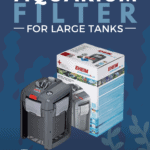Regardless of its size, every freshwater and saltwater fish tank needs an efficient filtration system that provides sufficient biological and mechanical functionality to keep the water clean and well-oxygenated.
Choosing the right filter for a big aquarium is undoubtedly a challenge. In this article, we explain how to pick the best aquarium filter for large tanks, as well as providing you with product reviews of our top five filtration systems that are ideal for a big setup.
Quick Comparisons Of The 5 Best Aquarium Filters For Large Tanks
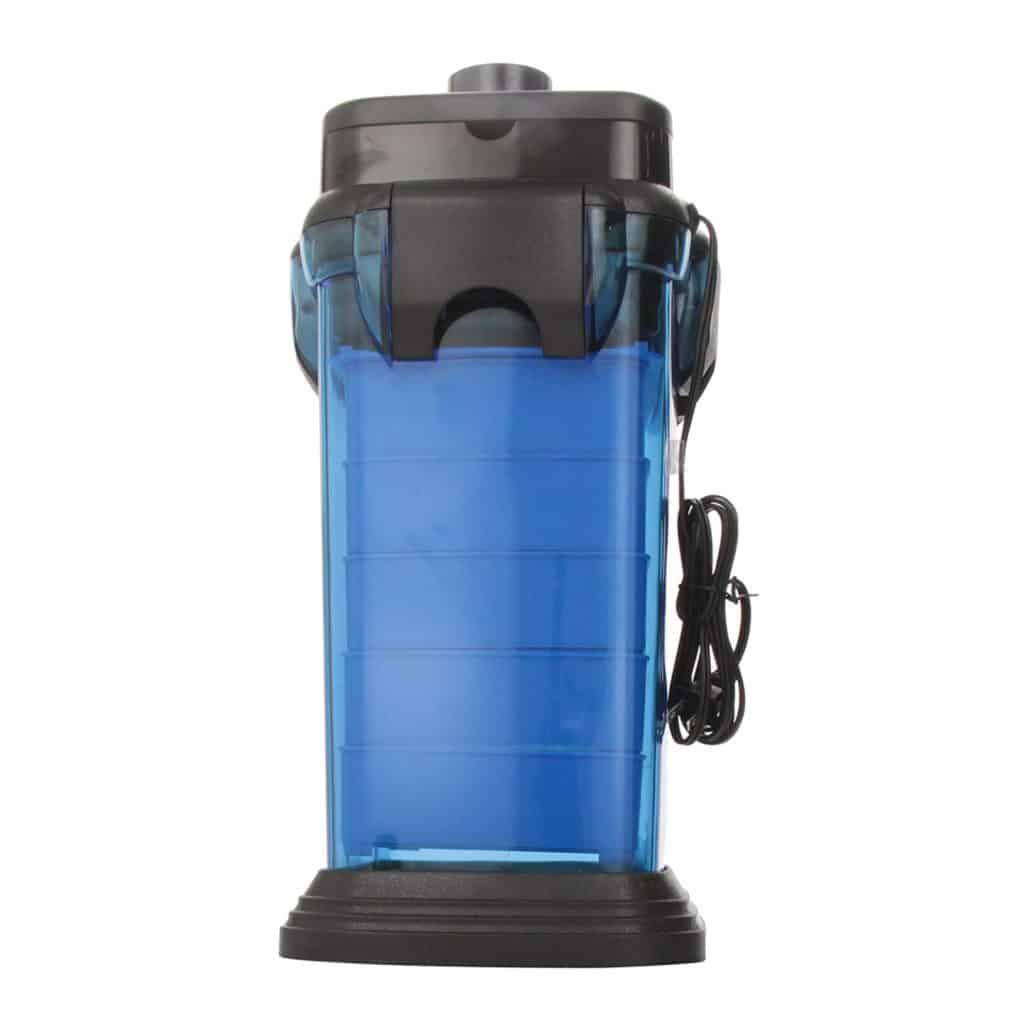
BRAND
Penn Plax Cascade 1500 Elite Aquarium Filter
DETAILS
- 200 Gallons
- 11.5” x 20.5” x 12”
- 350 GPH
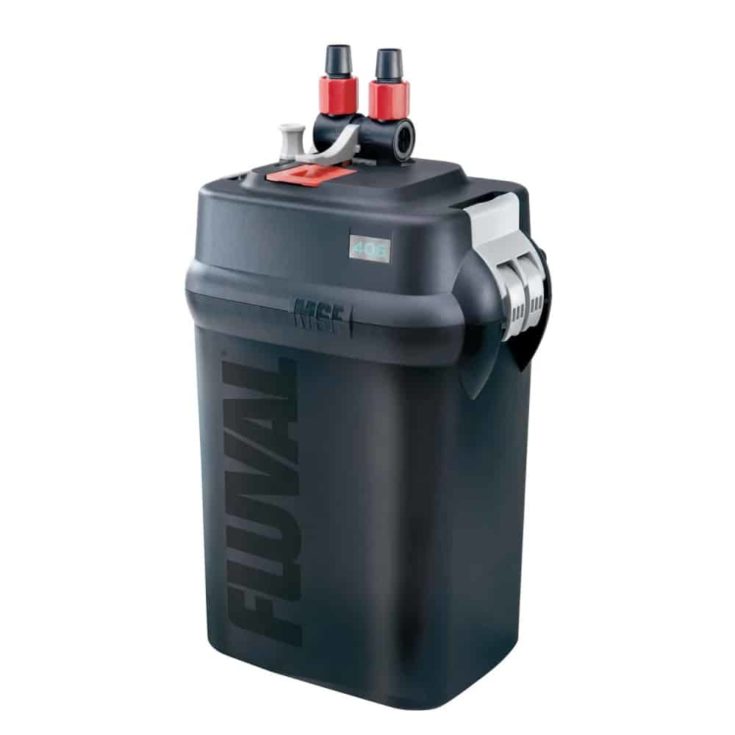
Fluval 406 External Filter
- 100 Gallons
- 9.5” L x 17.25” H x 7” W
- 400 GPH
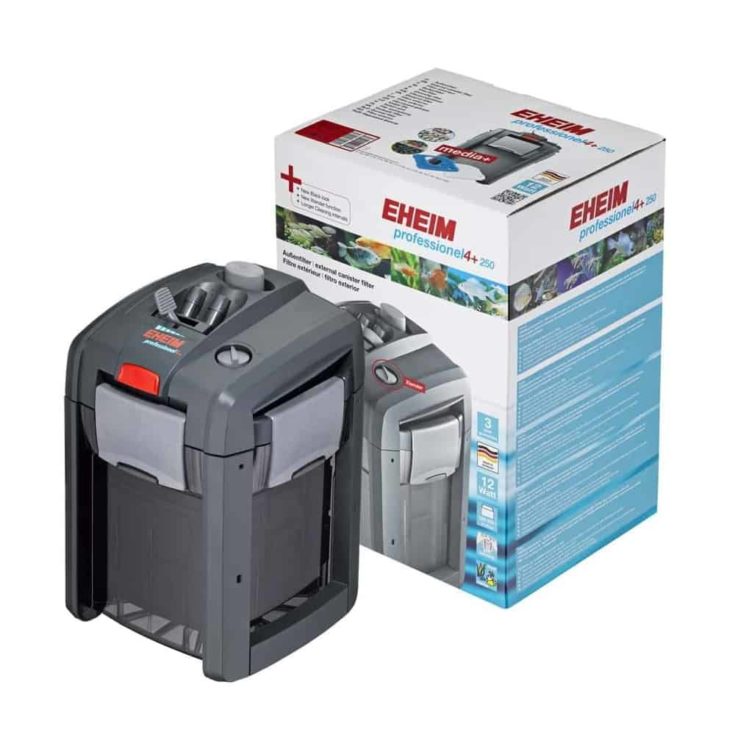
Eheim Pro 4
- 75 Gallons
- 10” L x 10” W x 14” H
- 280 GPH
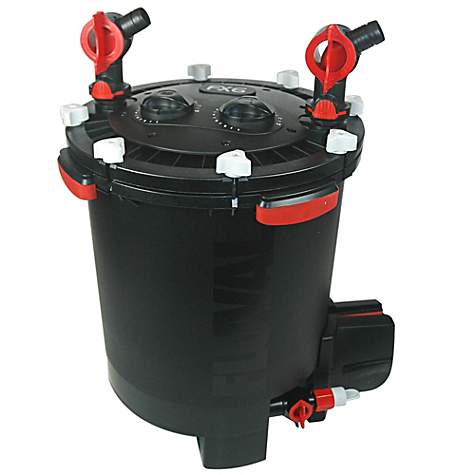
Fluval FX6 Canister Filter
- 110 Gallons
- 7.1” L x 13.9” W x 9.1” H
- 400 GPH
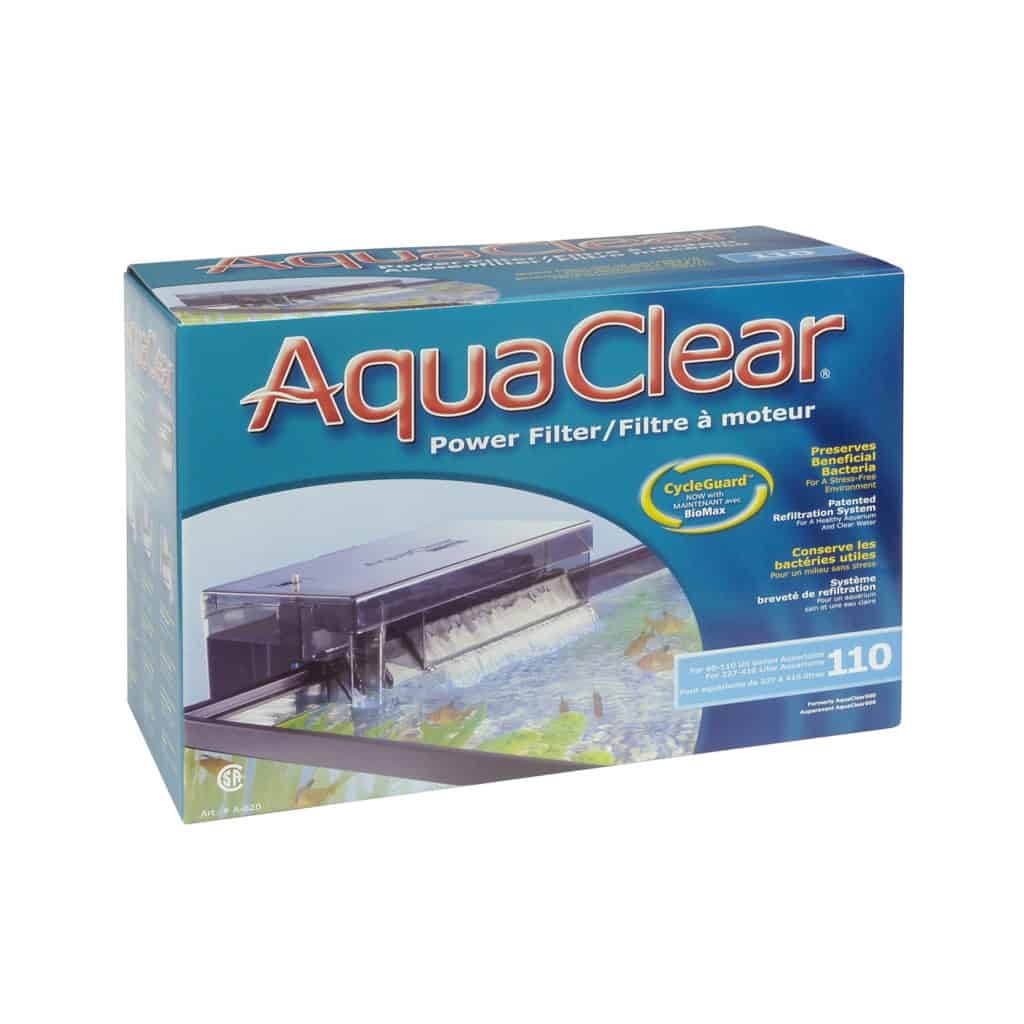
AquaClear CycleGuard Power Filter
- 200 Gallons
- 11.5” x 20.5” x 12”
- 350 GPH
Top 5 Aquarium Filters For Large Tanks Reviews
Now that you know more about what filter to choose for a large tank let’s take a look at five of our favorite products that fit the bill.
1. Penn Plax Cascade 1500 Elite Aquarium Filter

- 200 Gallons
- 11.5” x 20.5” x 12”
- 350 GPH
The Penn-Plax external canister filter is one of the best 200-gallon fish tank filter systems around. The unit comes complete with everything that you need to connect it to your aquarium. Start-up is via a push-button primer, and the unit has fully adjustable, 360-degree rotating valve taps so that you can alter and redirect the flow to suit your setup.
The filter system comes with large filter trays, input/output tubing, and filter media to get you started, although you can customize the media that you use to suit your requirements. The extra-large filter trays mean that you can use more filter media that requires less frequent replacement. The pump is super-quiet and efficient.
PROS
- Extra-large filter media trays
- Customizable filtration
- Fully adjustable flow
CONS
- Expensive
- Too much water bypass around filter compartments
2. Fluval 406 External Filter

- 100 Gallons
- 9.5” L x 17.25” H x 7” W
- 400 GPH
Fluval is a well-established company whose products are generally extremely good quality and very reliable.
The Fluval 406 External Filter comes with an instruction manual and is easy to set up. Thanks to the self-primer, it’s simple and hassle-free to get water flowing through the filter, and the noise reduction technology that’s been used in the design ensures that the pump is much quieter than many of the product’s competitors. Maintenance of the unit is a breeze thanks to the removable filter baskets and easy-lift clamps.
The only real drawbacks to the filter unit are that you don’t get much filter media or hose length included with it.
PROS
- Well-made and durable
- Extremely quiet operation
- Self-priming
CONS
- Could come with more filter media and hose
3. Eheim Pro 4

- 75 Gallons
- 10” L x 10” W x 14” H
- 280 GPH
I use Eheim filters on both my tanks, and I love their simple, easy to clean design and reliability.
This external canister filter has a push pump button to start the siphon process, and you can adjust the flow from zero to full-on, which is a handy feature if you have fish that don’t appreciate too much current through the tank. The media trays are designed so that you can lift them out individually for cleaning, and each tray has a triangular marker in one corner to ensure that you get them correctly aligned on replacement in the unit.
There’s a push-button release to disconnect the outlet and intake valve block from the unit for cleaning, making the process simple and quick to accomplish.
PROS
- User-friendly design
- Extremely quiet operation
- Self-priming
CONS
- Flow-rate can be variable
- Construction not robust
4. Fluval Canister Filter, FX6 Filter

- 400 Gallons
- 10” L x 10” W x 21” H
- 1600 GPH
If you’re looking for a 400-gallon aquarium filter, the Fluval FX6 external canister filter could be just what you need.
The unit has an extendable intake tube that enables you to adjust the filter to fit most tank sizes and shapes. The pump is self-priming; simply plug it in, and you’re good to go. There’s a special air evacuation feature that removes air bubbles from the system every 12 hours so that the maximum vacuum is always maintained.
The system utilizes mechanical, biological, and chemical filtration, and the unit comes pre-loaded with a full set of filter media that can be interchanged and customized to suit your setup. The purge valve system makes maintenance straightforward, and the multi-directional output nozzle enables you to direct the water flow to suit your fishes’ preferences.
PROS
- User-friendly design
- Customizable filter media
- Self-priming
CONS
- Sponge filter media needs frequent replacement
- Bulky design
5. AquaClear CycleGuard Power Filter

- 110 Gallons
- 7.1” L x 13.9” W x 9.1” H
- 400 GPH
The AquaClear CycleGuard Power Filter is a HOB unit that uses multi-stage filtration to maintain excellent water quality in large tanks. The system incorporates mechanical, biological, and chemical filtration that uses throwaway filter cartridges, and you get a full set of filter media with the system to start you off.
This filtration system features a gentle waterfall design that returns clean water to the tank without creating excessive surface agitation, making this a great choice for fish and plants that don’t appreciate a strong current in their habitat. The design also ensures good water oxygenation.
PROS
- Gentle waterfall return design
- Filter media included
- Three-stage filtration
CONS
- Filter cartridges are expensive to replace
What Is Considered A Large Tank?
A big fish tank is generally defined as one with a capacity of 75 gallons or more. Most large home aquariums are between 75 and 100 gallons, although you can get in-between sizes, and, if you have space, you could buy a massive tank that holds 400 gallons or even more.
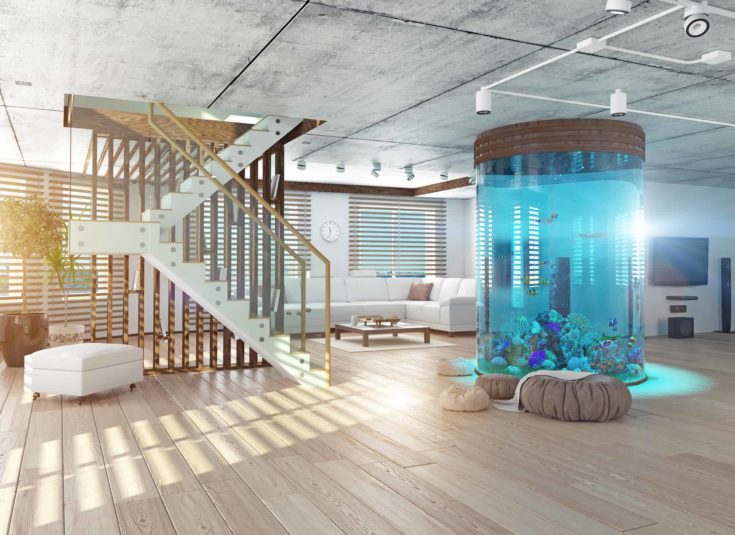
However, it’s worth considering that the larger the tank is, the more powerful the filtration system you need, and the maintenance of a very large aquarium is more time-consuming and labor-intensive than it is for a smaller setup. You can check our reviews for the Best 5 Gallon Aquarium Filter for smaller aquariums.
How Much Filtration Is Needed For Large Tanks?
So, how much filtration is needed for large tanks?
The general rule of thumb for filtration rates is that all the water contained in your aquarium passes through your filtration system at least four times every hour. So, a 100-gallon tank requires a flow rate of at least 400 gallons per hour (GPH).
When buying a filter for my goldfish tank, I always go for a unit that provides a slightly higher GPH rate than I need. That extra flow ensures that the water has all the oxygen that my fish need and the filtration unit can cope with the amount of waste that dirty goldfish produce.
GPH Strength
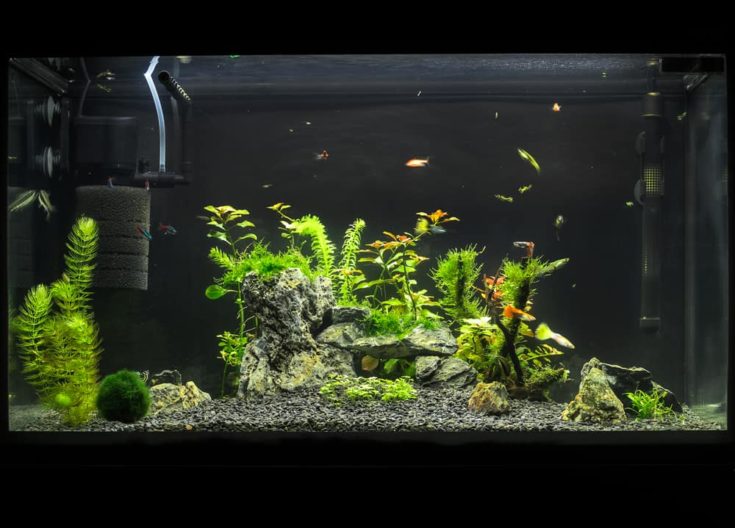
The GPH rate varies greatly, depending on the filter strength and type, the efficiency of the unit, and its condition. If you decide to go for a higher GPH, that’s great, as it means that conditions in your aquarium will be better for your fish. However, you should be mindful of how the power of the flow through the tank will affect your fish and plants.
For example, betta fish dislike too much water movement and quickly become stressed if they cannot swim comfortably. One solution to that problem is to buffer the flow with plants or decorations or pick a filtration unit that has directional valves that you can adjust to suit your requirements.
GPH And Turnover Rate
The turnover rate is not the same as GPH. The turnover rate describes the efficiency of the filtration unit and its pump, rather than how much water the system can circulate around the tank.
“Dead Spots”
If the GPH of the filter is not sufficient for the size of the tank and its environment, “dead spots” may form. Dead spots are pockets of water that are not agitated by the action of the water current and usually form if the GPH provided by the filter unit is not powerful enough to circulate all the water in the aquarium equally.
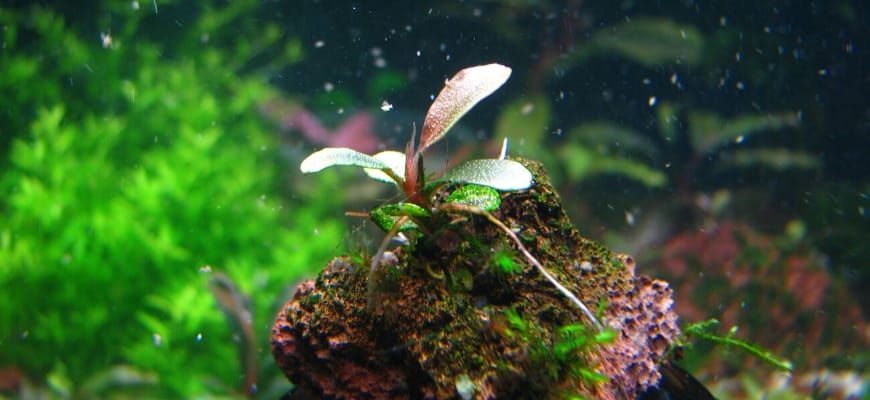
The water in these dead spots is stale and stagnant, providing the perfect environment for harmful bacteria that can cause health problems for your fish.
Dead spots are the main reason that I suggest you use a filter that has a higher GPH than the tank capacity warrants. That’s because the basic GPH doesn’t take account of the aquascape in the tank. Essentially, the more plants, rocks, driftwood, and other decorations that you have, the stronger the water current must be to reach all areas of the aquarium.
In large tanks, the best way to combat dead spots is to use two filtration units, one at each end of the aquarium, to ensure that water in all areas of the tank is circulated through the filter units.
Does Sand Get Caught In Large Filters?
Under normal operational circumstances, sand won’t get sucked into a large filtration unit. However, problems can arise during routine tank maintenance, and sometimes burrowing fish can cause clouds of sand to billow around the tank so that it ultimately ends up in the filter unit. Most times, sand in the filter just makes more work for you, as you have to clean the unit more often than you would ordinarily need to. However, sand can sometimes cause damage to the filter.
Clogged Filter
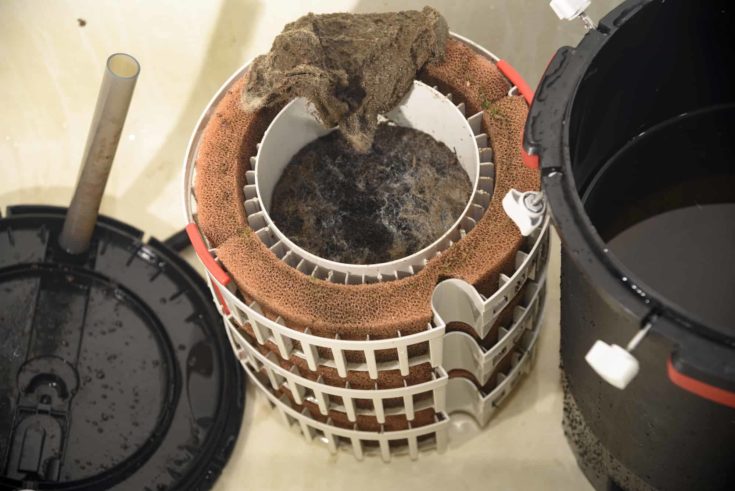
If sand is not cleaned out of the filter, it can clog the unit, meaning that fish waste, leftover food, etc. gets left in the tank, where it will decompose and release harmful ammonia into the water. The biological media in some systems can become clogged by sand, which affects the efficiency of the bacteria that process waste and purify the water.
Impeller Damage
The mechanical element of all filtration systems uses an impeller or motor that draws water up through the filter unit and the enclosed media before returning the clean, polished water to the tank. If sand is sucked into the impeller, it can damage the filter’s moving parts and stop the impeller from turning.
When the impeller stops working, the filter no longer pulls water from the aquarium. The only solution is to replace the filter unit altogether or send it to the manufacturer for repair. That’s why many power filter manufacturers recommend using only pebbles, gravel, or glass marbles, rather than sand as a substrate.
Damage To Filter Parts
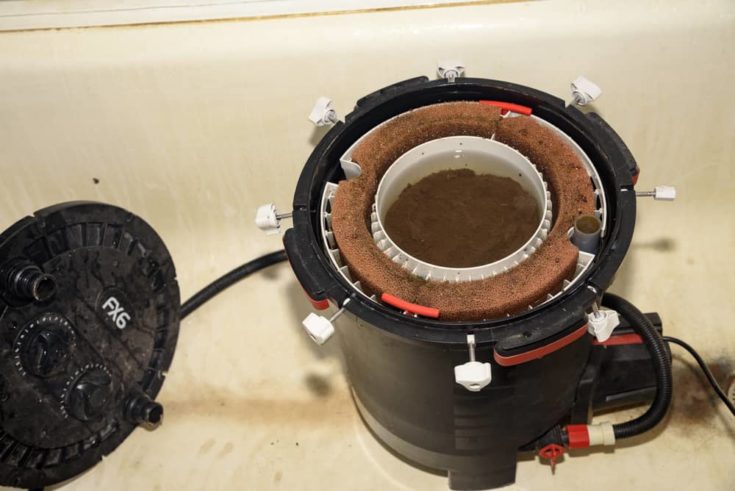
Even if the impeller is not affected, sand can still inflict damage on the internal parts of the filtration unit by wearing down any components that are made from plastic. That can result in the filter not working as efficiently as it should. Tiny holes may even develop in the filter housing, causing leaks and preventing the unit from working properly.
What To Look For In Aquarium Filters For Large Tanks
Large tanks have their own particular requirements when it comes to choosing suitable filtration systems. The kind of filter that you choose will depend on your individual tank setup. However, there are several general considerations that apply to all hobbyists who keep large aquariums.
Appropriate Capacity
As mentioned previously in this guide, it’s essential that you choose a filter with the appropriate capacity for your fish tank.

Check the GPH on the product packaging and pick a filter that offers slightly more capacity than you need for your tank size. If you have a very large tank, and you’re planning on using two filters, pick units that are exact GPH for your aquarium so that you don’t create a current that’s too powerful for the tank residents.
Remember that a tank with a lot of decoration and planting will be more prone to developing pockets of stale water, especially in the corners. So, make sure that you take that into consideration when you buy your filter.
Filtration Stages
Aquarium filtration has three elements:
- Mechanical
- Chemical
- Biological
Each of these processes is essential for a healthy environment in which your fish can thrive, and it’s important that you understand how each element of the filtration process works.
Mechanical
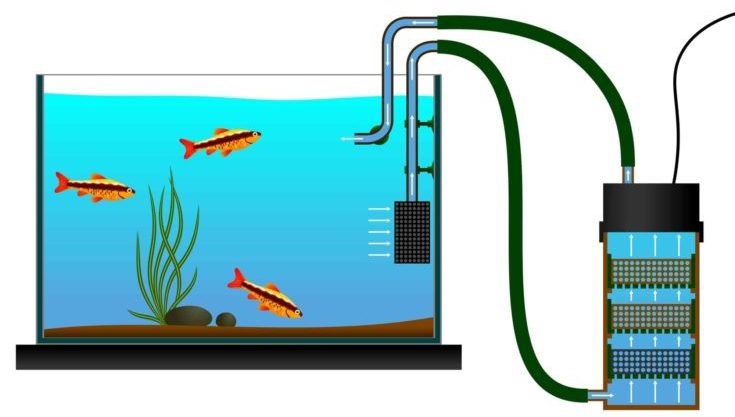
The mechanical element of the filtration system is the process by which particles of fish waste, uneaten food, and general detritus are removed from the tank. The filter unit has a motor that powers an impeller, drawing water up from the aquarium, through the filter media, and back into the tank.
The filter media can be made of foam, pads, floss, paper pleats, and diatomaceous earth, and its function is to catch and hold the particles of waste. The filter media must be cleaned regularly by rinsing it through in tank water to remove excess particulate before it turns to sludge and clogs the filter. If you don’t clean the filter media, the mechanical filter will eventually become blocked, and the water flow will decrease.
If you don’t clean the mechanical filter at least once a month, it will end up holding large quantities of decomposing matter that will slowly overload the biological filter and contaminate the water.
Chemical
The chemical filtration element of the system is designed to extract toxins, heavy metals, and chemicals from the water as it passes over some kind of chemical resin or media. Traditionally, activated carbon was the chemical filtration media of choice, but you can now buy specially targeted products that remove specific substances from the water.
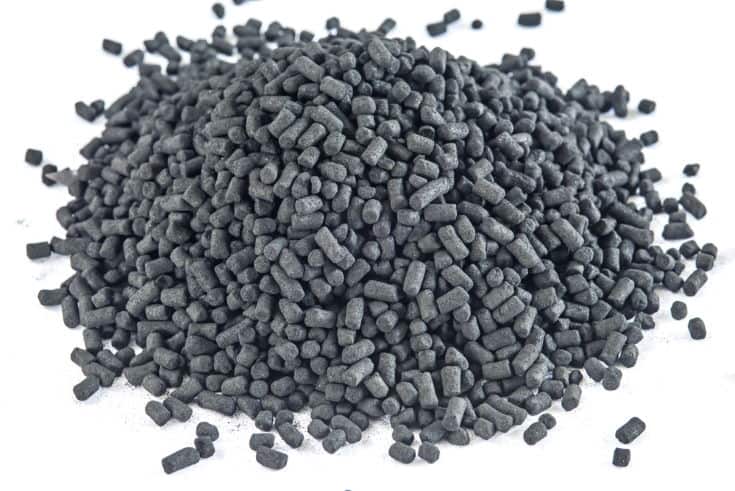
You can incorporate these media into the filtration system as a way of reducing the amount of maintenance that you need to do and to improve the quality of the water. That being said, you still need to carry out weekly partial water changes to keep levels of nitrates to a minimum.
Chemical filtration media generally needs to be regularly replaced for it to remain effective. Also, some fish disease treatments are extracted by chemical filtration media, so you will need to remove that part of the filtration system while the fish are undergoing treatment. Alternatively, remove the fish and treat them in a dedicated hospital tank with a filtration system that lacks the chemical element.
Biological
Biological filtration uses several different species of bacteria to process the toxic chemical byproducts that are created by decomposing fish waste, leftover food, plant debris, and general detritus in a process called the Nitrogen Cycle.
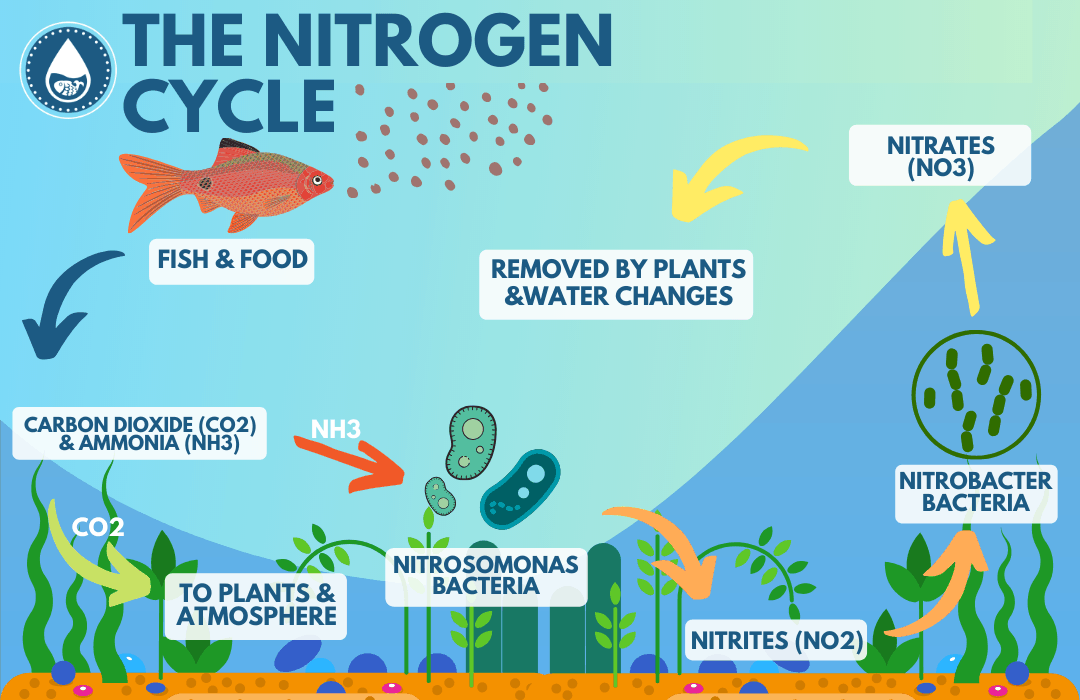
In the first part of the Nitrogen Cycle, ammonia is produced. Ammonia is highly toxic to all aquarium inhabitants and can be fatal to your fish if levels of the chemical get too high. In the next part of the Nitrogen Cycle, ammonia is broken down by Nitrosomonas bacteria into nitrites. Nitrites are also harmful to life in the aquarium if not removed. Nitrites are consumed by another kind of bacteria called Nitrobacter and are converted into nitrates.
Nitrates are much less harmful to fish and invertebrates than ammonia and nitrites, but if they are allowed to accumulate in the water, high levels can trigger algal blooms. So, weekly partial water changes are required to remove nitrates, ideally to levels of less than 20ppm (parts per million).
The bacteria that drive the Nitrogen Cycle need oxygen to survive, as well as somewhere on which they can form colonies. The biological element of a filter system consists of filter media within the unit on which the bacteria can grow. Because of the bacteria’s need for oxygen, the most efficient biological filters are those where the biological media is exposed to the air.
Type Of Filter
There are many different types of filters, but the best designs for use in very large tanks are canister and power filters.
Power Filters
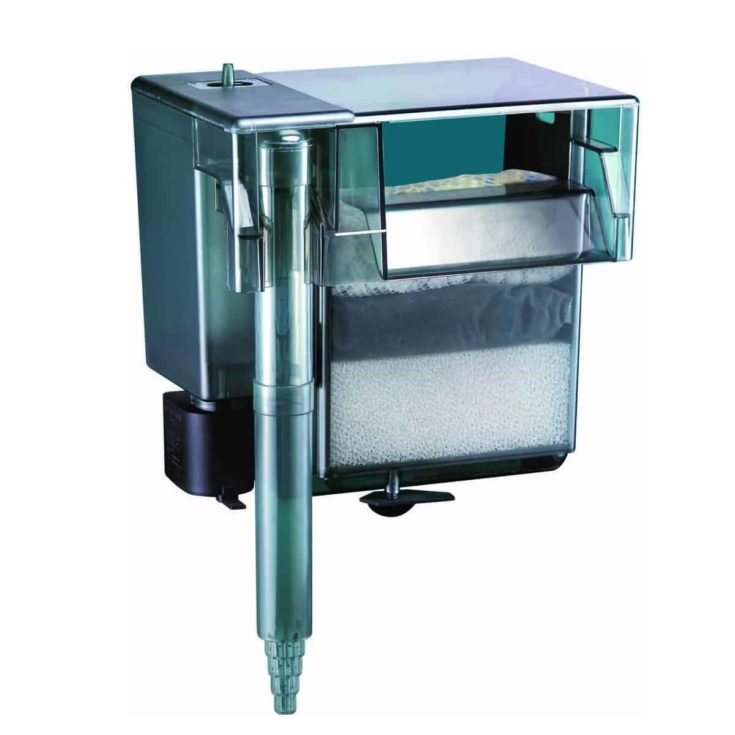
Power filters come in different designs but these units are basically designed to hang on the back of the tank. Most power filters utilize all three types of filtration, and they are extremely efficient and easy to maintain. Power filters come as complete units with an integral pump and filter cartridges, which require regular cleaning and replacement to remain effective. All three phases of filtration are contained within the filter unit.
Many modern power filters come with bio-wheels. A bio-wheel is a biological filter that’s formed by a wheel of pleated material. The wheel spins as water is drawn over it by the pump, providing the bacteria colonies on the surface with a good supply of oxygen.
Power filters are not the best choice for a heavily planted aquarium as they cause too much surface agitation that is not compatible with a CO2 injection system. Also, when used in a saltwater tank, a power filter can cause salt creep on the underside of the tank hood and the lighting unit. In addition, species of fish that are not strong swimmers can become stressed if the flow in the tank is too strong, so a power filter may not be the best choice in that case.
Canister Filters

Canister filters usually live underneath the tank in the cabinet. These are pressurized units that carry out all three types of filtration. Canister filters come as a complete unit with an integral pump or in a modular form that requires a separate pump. Modular units can be useful as they offer the versatility to be combined with another form of filtration, such as a wet-dry unit.
Canister filters usually have a U-tube to draw the water into the unit and a spray bar to return the water to the tank. Once you start the system, the water is siphoned from the aquarium into the canister filter unit, where it passes through various chambers that contain filter media before being returned to the tank.
Canister filters are powerful and super-efficient, making them a great choice for a very large aquarium.
Maintenance
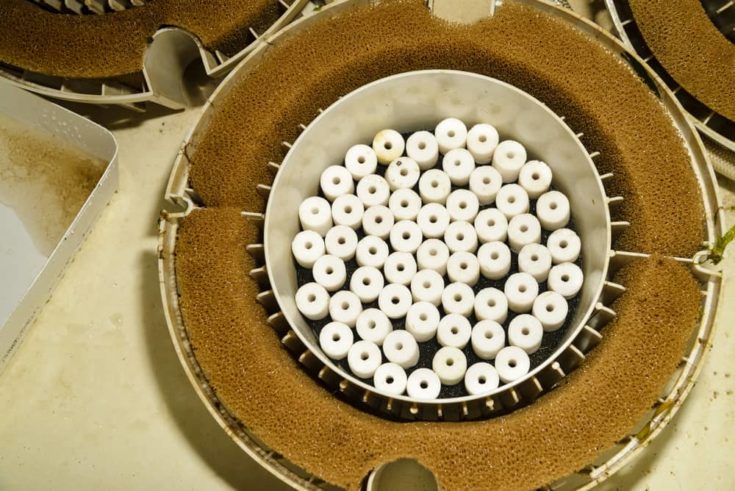
Regardless of the type of filter system that you use, some maintenance work will be required to keep everything working efficiently and effectively.
If the filter system contains cartridges that house the filter media, they will need replacement periodically, and you will need to wash the cartridges through in tank water each month to get rid of the sludge that would otherwise clog the unit.
To ensure that the impeller is free and able to spin without obstruction, you should make it part of your cleaning routine to check that no bits of debris are trapped in the impeller housing and clean it as necessary.
Practical Considerations
When choosing a filter for a large tank, there are a few practical considerations that must be taken into account:
Space
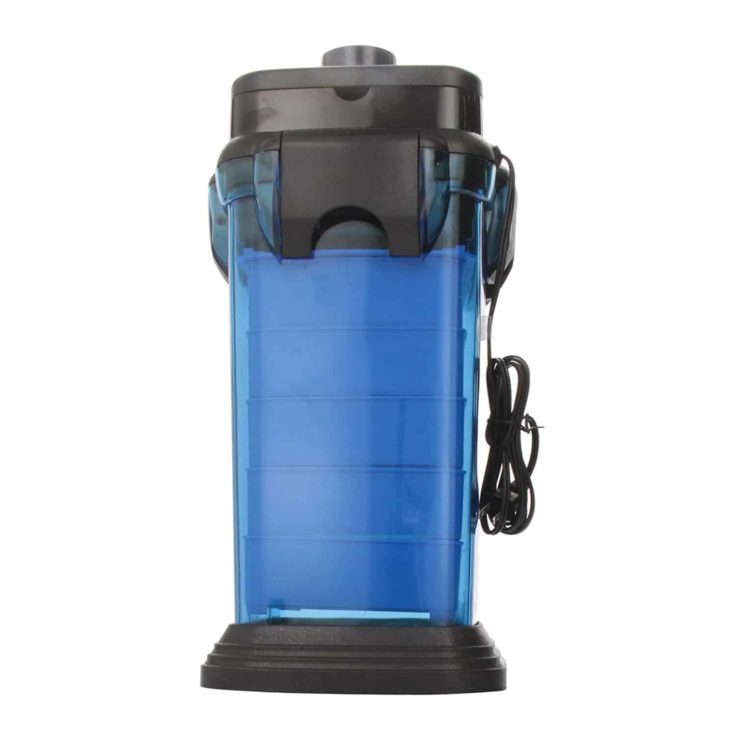
Your first consideration should be the amount of space that you have both inside and outside the tank. If you have a very large aquarium that’s in a place without much room around it, you don’t want a HOB (hang-on-back) filter that’s going to be awkward to get to for maintenance. So, a canister filter that fits underneath your tank would be the better choice.
Aesthetics
You want to enjoy watching the residents of the tank and your aquascaping efforts, not the sight of a huge, black filter box, especially if you need two filter units to manage the environment efficiently.
If that’s the case, you need some form of external filter system that won’t spoil your view.
Ease Of Maintenance
If you have a busy lifestyle, you may not have the time to spend hours cleaning a complex filter unit. If that’s the case, choose a system that is easy and quick to maintain.
In Conclusion
We hope that you found this guide and product reviews helpful.
Of the products that we looked at, our favorite is the AquaClear CycleGuard Power Filter. This product is powerful enough to keep a large tank clean, but the gentle waterfall return means that fish and plants won’t be buffeted around by a strong flow. The three-stage filtration system gives you everything that you need to provide your fish with a pristine environment in which to thrive. Also, the HOB design of this high-quality external filter is ideal for you if you don’t want an unsightly unit in your tank but you don’t have an aquarium cabinet in which to hide a canister filter system.
